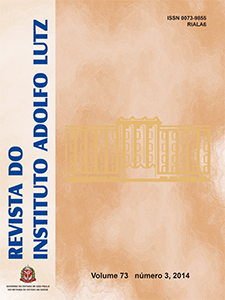Abstract
Ambrosia is a type of Dulce de Leche hand-made with milk, eggs and sugar, widely consumed in South America, and it is commonly sold in street markets, supermarkets and candy shops. Food contamination by pathogenic micro-organisms usually occur during the processing steps, at the distribution centers, at the retail market or in the consumer home. This study aimed at evaluating the behavior of the pathogenic strains of Escherichia coli enterohemorrhagic (EHEC) ATCC 43895, enteropathogenic (EPEC) INCQS 00182 and enteroinvasive (EIEC) ATCC 43893 in ambrosia samples. Aliquots of ambrosia were experimentally contaminated by the strains analyzed in this study. Detections of the inoculated microorganisms were done at 0, 1, 2, 3, 4, 5, 10, 20 and 30 days of storage. EHEC was recovered from all of analyzed samples until five days after infection. EPEC survived in ambrosia and it was isolated until the fourth day of the experiment. EIEC strain remained viable during the 30 days of storage. The analyzed pathogenic strains of E. coli showed different behavior in ambrosia, but all of them demonstrated potential danger to the consumers health. This study works for warning to adopt appropriate hygiene and sanitary actions during the ambrosia production, packaging and manipulation.References
1. Brasil. Ministério da Agricultura, Pecuária e Abastecimento. Regulamento técnico para fixação de identidade e qualidade de doce de leite. Portaria nº 354, de 04/09/97. Diário Oficial [da] União, Brasília, 08 set. 1997. Seção I, p. 19685.
2. Brasil. Agência Nacional de Vigilância Sanitária – Anvisa. Regulamento Técnico sobre Padrões Microbiológicos para Alimentos. Resolução-RDC nº12, de 02/01/01, Diário Oficial [da] União, Brasília, 10 jan. 2001. Seção I, p. 45-53.
3. WHO. World Health Organization. In: Food Safety, Microbiological risks. 2013b. [acesso 2013 Mai 4]. Disponível em: [http://www.who.int/foodsafety/micro/general/en/index.html].
4. WHO. World Health Organization. In: Food Safety. Foodborne disease. 2013a. [acesso 2013 Mai 4]. Disponível em: [http://www.who.int/foodsafety/foodborne_disease/en/].
5. Meng J, Doyle MP, Zhao T, Zhao S. Enterohemorrhagic Escherichia coli. In: Doyle MP, Beuchat LR., Montville TJ. Food microbiology: fundamental and frontiers. 2. ed. Washington: ASM; 2001. p.141-77.
6. Kaper JB, Nataro JP, Mobley HLT. Pathogenic Escherichia coli.Nat RevMicrobiol. 2004; 2:123-40.
7. Torres AG, Zhou X, Kaper JB. Adherence of diarrheagenic Escherichia coli strains to epithelial cells. Infect Immun. 2005; 73:18-29.
8. Franco BDGM, Landgraf M. Microrganismos Patogênicos de Importância em Alimentos. In: Franco BDGM, Landgraf M. Microbiologia dos alimentos.São Paulo: Atheneu; 2003. Cap 4. p. 33-81.
9. Nataro JP, Kaper JB. Diarrheagenic Escherichia coli. Clin Microbiol Rev. 1998; 1:142-201.
10. Ordoñez JG e Trabulsi LR. Escherichia coli Enteroemorrágica (EHEC) In: Trabulsi LR, Altherthum F, Goompertz OF, Candeias, JAN. Microbiologia 4ª ed. Rio de Janeiro: Atheneu; 2004. Cap 37. p. 284-8
11. Brasil. Ministério da Agricultura, Pecuária e Abastecimento. Métodos Analíticos Oficiais para Análises Microbiológicas para Controle de Produtos de Origem Animal e Água. Instrução Normativa nº 62, de 26/08/2003. Diário Oficial [da] União, Brasília, 18 set. 2003. Seção I, p. 14-51.
12. Timm CD, Silva DT, Dias PA, Conceição RCS. Sobrevivência de micro-organismos patogênicos em ambrosia. Semina: Ciências Agrárias2013;34(4):1829-34.
13. Timm CD, Conceição RCS, Coelho FJO, Roos TB, Tejada LS, Quevedo OS, et al. Avaliação microbiológica de doce de leite pastoso. Rev Inst Adolfo Lutz. São Paulo. 2007; 66:275-7.
14. Landgraf M. Microorganismos indicadores.In: Franco BDGM, Landgraf M. Microbiologia dos alimentos.São Paulo: Atheneu; 2003. Cap 3. p.1 27-31.
15. Peixoto D, Weckwerh PH, Simionato EMRS. Evaluation of the microbiological quality of confectionery products sold in Ribeirão Preto – SP. Alim Nutr. 2009; 20(4):611-5.

This work is licensed under a Creative Commons Attribution 4.0 International License.
Copyright (c) 2015 Instituto Adolfo Lutz Journal
